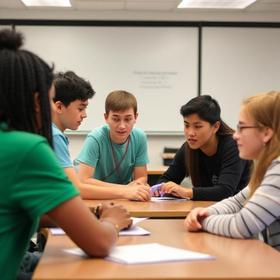Davis High School is a public school located in Kaysville, Utah, United States. It is operated by the Davis School District. Known as the Davis Darts, the mascot of the school is Dart Man.
Serving 2,225 students in grades 10-12, Davis High School ranks in the top 10% of all schools in Utah for overall test scores (math proficiency is top 20%, and reading proficiency is top 20%).
The percentage of students achieving proficiency in math is 59% (which is higher than the Utah state average of 40%). The percentage of students achieving proficiency in reading/language arts is 60% (which is higher than the Utah state average of 43%).
The student-teacher ratio of 26:1 is higher than the Utah state level of 21:1.
Minority enrollment is 11% of the student body (majority Hispanic), which is lower than the Utah state average of 29% (majority Hispanic).
Quick Facts (2025-26)
- Grades: 10-12
- Enrollment: 2,225 students
- Student-Teacher Ratio: 26:1
- Minority Enrollment: 11%
- Graduation Rate: 96% (Top 5% in UT)
- Overall Testing Rank: Top 10%
- Math Proficiency: 59% (Top 20%)
- Reading Proficiency: 60% (Top 10%)
- Science Proficiency: 41% (Btm 50%)
- Source: National Center for Education Statistics (NCES), UT Dept. of Education
Top Rankings
Davis High School ranks among the top 20% of public schools in Utah for:
Category
Attribute
Overall Rank
Math Proficiency
Reading/Language Arts Proficiency
Graduation Rate
School Overview
Davis High School's student population of 2,225 students has grown by 7% over five school years.
The teacher population of 86 teachers has stayed relatively flat over five school years.
Grades Offered
Grades 10-12
Total Students
2,225 students
Gender %
Total Classroom Teachers
86 teachers
Year Founded
1914
School Calendar
School Rankings
Davis High School ranks within the top 10% of all 957 schools in Utah (based off of combined math and reading proficiency testing data).
The diversity score of Davis High School is 0.21, which is less than the diversity score at state average of 0.46. The school's diversity has stayed relatively flat over five school years.
Overall Testing Rank
#79 out of 957 schools
(Top 10%)
(Top 10%)
Math Test Scores (% Proficient)
59%
40%
Reading/Language Arts Test Scores (% Proficient)
(20-21)60%
43%
Science Test Scores (% Proficient)
(20-21)41%
45%
Student-Teacher Ratio
26:1
21:1
American Indian
n/a
1%
Asian
1%
2%
Hispanic
6%
20%
Black
1%
1%
White
89%
71%
Hawaiian
1%
1%
Two or more races
2%
4%
All Ethnic Groups
Graduation Rate
96%
88%
Eligible for Free Lunch
7%
24%
Eligible for Reduced Lunch
1%
6%
School Statewide Testing
School District Name
Source: National Center for Education Statistics (NCES), UT Dept. of Education
School Notes
- School Mascot: Dart Man
Profile last updated: 02/09/2025
Frequently Asked Questions
What is Davis High School's ranking?
Davis High School is ranked #79 out of 957 schools, which ranks it among the top 10% of public schools in Utah.
What schools are Davis High School often compared to?
Davis High Schoolis often viewed alongside schools like Layton High School, Farmington High School by visitors of our site.
What percent of students have achieved state testing proficiency in math and reading?
59% of students have achieved math proficiency (compared to the 40% UT state average), while 60% of students have achieved reading proficiency (compared to the 43% UT state average).
What is the graduation rate of Davis High School?
The graduation rate of Davis High School is 96%, which is higher than the Utah state average of 88%.
How many students attend Davis High School?
2,225 students attend Davis High School.
What is the racial composition of the student body?
89% of Davis High School students are White, 6% of students are Hispanic, 2% of students are Two or more races, 1% of students are Asian, 1% of students are Black, and 1% of students are Hawaiian.
What is the student-teacher ratio of Davis High School?
Davis High School has a student ration of 26:1, which is higher than the Utah state average of 21:1.
What grades does Davis High School offer ?
Davis High School offers enrollment in grades 10-12
What school district is Davis High School part of?
Davis High School is part of Davis School District.
School Reviews
5 10/10/2025
I loved this school. It was the second high school I went to and it was my favorite. The academics were awesome. I took 6 AP classes my senior year and the teachers all were willing to work with us and wanted us to pass the exams. The math department is fantastic they have a near 100% pass rate for the last 10 years or something close to that. I know everyone passed both Calculus AB and BC (depending on which ones they took) the year took those exams (my junior year). The building itself is awesome. My only complaint is the single doors and narrow stairways that we were trying to squeeze a ton of students out of during firedrills and between classes, but it wasn't too bad, you just learned quickly which routes were the quickest and there was plenty of time.
1 10/10/2025
Their robotics team is abrasive and hard to work with. The school environment is toxic and they teach bad behavior.
Review Davis High School. Reviews should be a few sentences in length. Please include any comments on:
- Quality of academic programs, teachers, and facilities
- Availability of music, art, sports and other extracurricular activities
Recent Articles

Bullying, Name-Calling & Put-Downs: Parent Guide 2025
Practical tips for parents to address bullying, name-calling, and put-downs鈥攚ith 2025 data, policies, and expert strategies.

What Is a Magnet School? (2025 Guide)
Explore what a magnet school is, how it works, and its benefits in 2025. Clear explanation for parents, students, and educators.

Cooperative Learning in 2025: Evidence, Best Practices & Challenges
Explore cooperative learning in 2025鈥攏ew data, updated practices, expert insights for educators and families.





